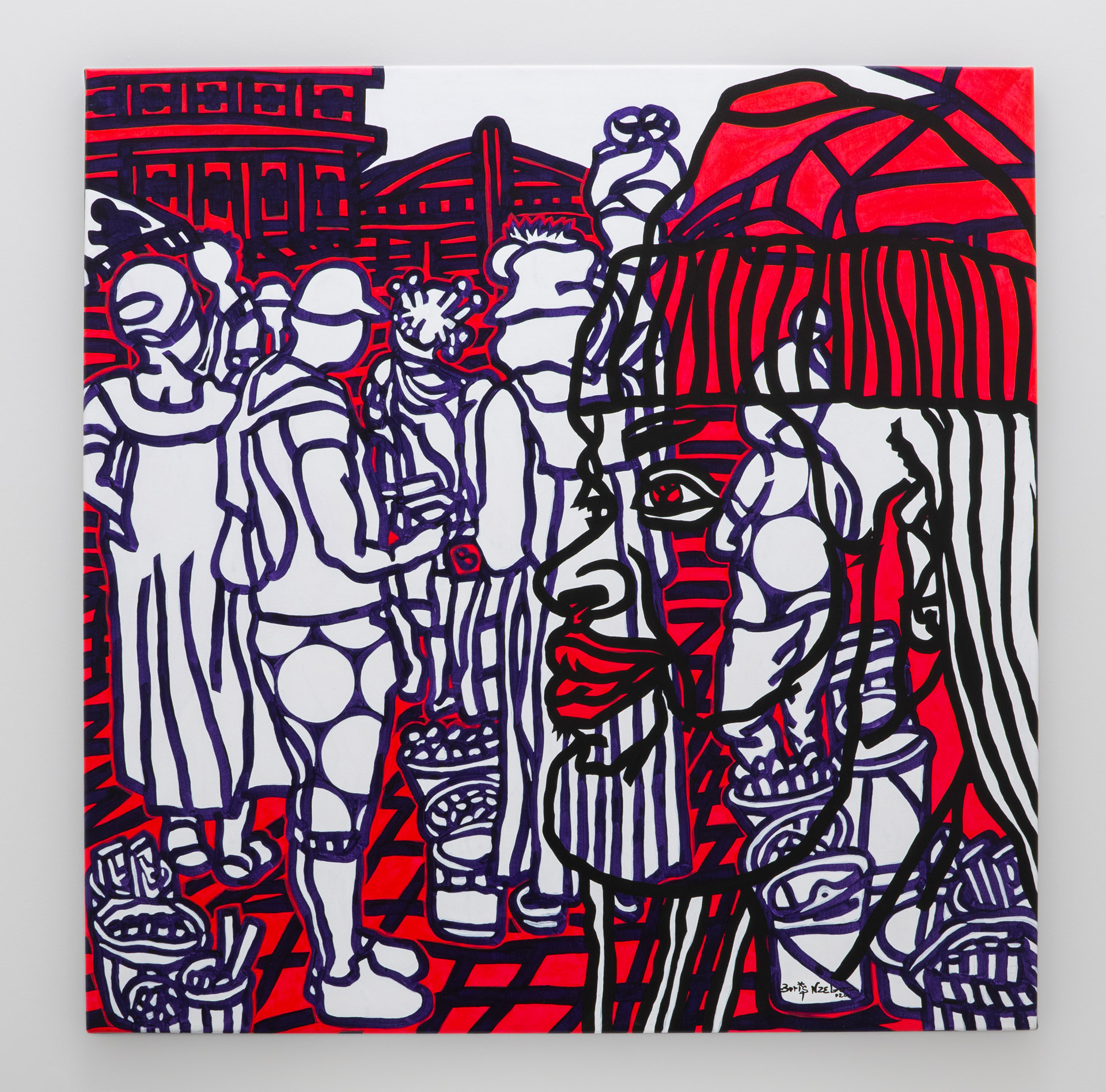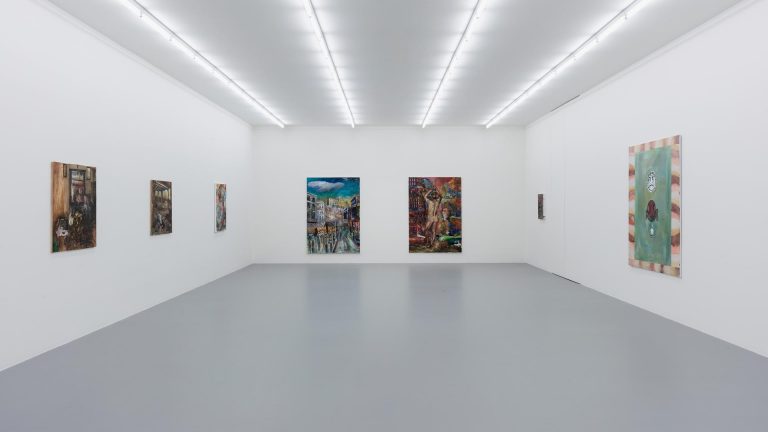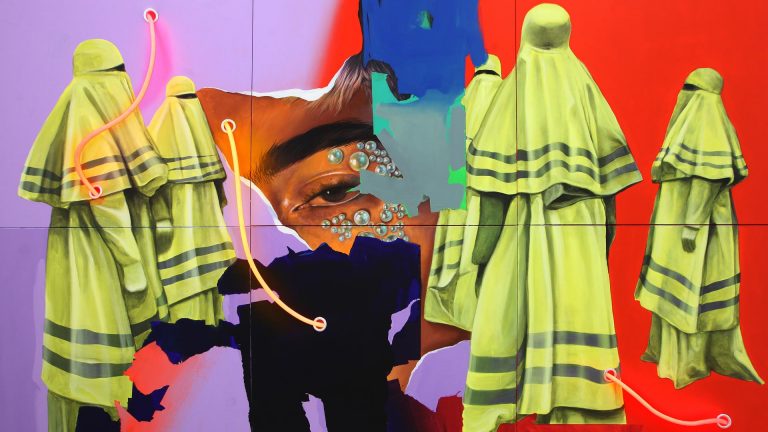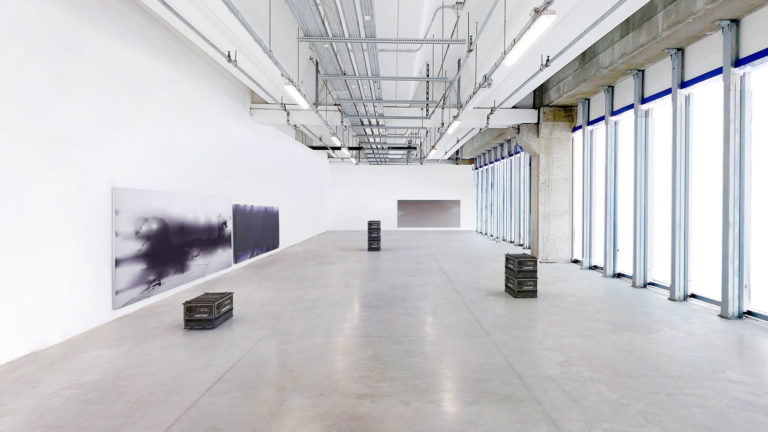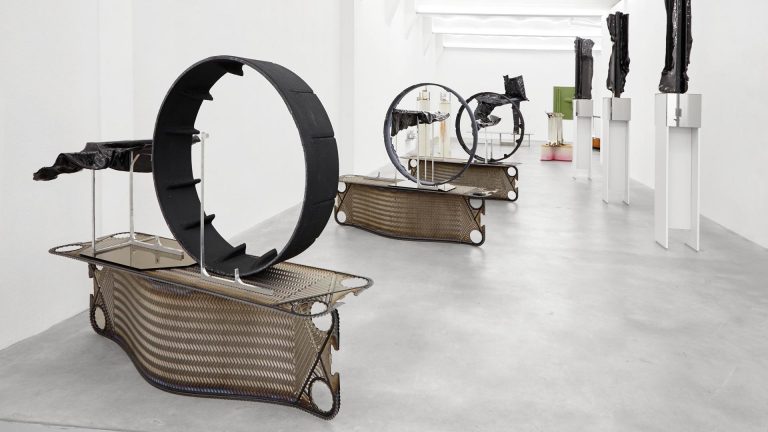Artists: Gerald Chukwuma, Jeremy Demester, Ameh Egwuh, Troy Makaza, Boris Nzebo, Monsieur Zohore
Exhibition title: Travels with Herodotus: A Journey through African Cultures
Curated by: Domenico de Chirico
Venue: Galleria Bianconi, Milan, Italy
Date: May 26 – July 16, 2021
Photography: all images copyright and courtesy of the artists and Galleria Bianconi, Milan
Galleria Bianconi presents Travels with Herodotus: A Journey through African Cultures, an exhibition opened from May 26 to July 16, 2021 and curated by Domenico de Chirico. As the title implies, the exhibition aims at giving life to an ideal journey of exploration through African contemporary art.
Through the comparison between the works of six artists belonging to different generations and countries – Gerald Chukwuma (Nigeria 1973), Jeremy Demester (France 1988), Ameh Egwuh (Nigeria 1996), Troy Makaza (Zimbabwe 1994), Boris Nzebo (Gabon 1979), and Monsieur Zohore (USA 1993) – the exhibition outlines an articulated, yet harmonious, portrait of the African art scene by means of an “exposition of research”, according to Herodotus’ interpretation of the word.
“Visual orchestra” is the definition given by Gerald Chukwuma to his work: wooden planks assembled, carved, blackened, chiseled, enriched with bright colors, and illuminated by the pieces of aluminum cans and telephone cards found by the artist on the street, give life to a surprising visual melody intertwining ancient symbols, historical and contemporary references.
In After (2020), here exhibited, Gerald Chukwuma represents elements of the Ikwokirikwo traditional dance of the Igbo people in Nigeria, giving voice to the history and values of a culture that the established power seeks to erase. Chukwuma’s work wants to underline the vital importance of free and creative expression as a form of resistance to daily indoctrination, to the manipulation of the media desired by the ruling powers to cancel our knowledge of history as well as of the present.
Voodoo, another founding element of African culture and tradition, is at the core of Jeremy Demester’s artistic research. Demester lives and works between France and Benin, where he creates works inspired by the world of spirits in Ouidah, the city of revenants according to voodoo tradition. The two works exhibited here for the first time, Times of grace VI (2021) and Djemy (2021), belong to this inspiration. Here he embraces the infinite metamorphoses of this religion: from objects of worship to intense colorism rich in primordial energies.
As Annabelle Gugnon (2018) writes, “Jeremy Demester’s painting is action, vision and prose. In search of new possibilities in the world, the painter probes experience through intuition. This is his guide. In front of the work, intuition favors amazement over certainty and gets the painter to approach the impossible.”
In Quick Pic (2021) and My cat, a book and my imaginations (2020) – two works by the young Nigerian artist Ameh Egwuh – two solitary female figures stand out against a domestic landscape populated by lines and geometric patterns inspired by scarification practices – that is, engraving and decoration of the skin in the rites of passage to adulthood – traditional of the ancient Ife art. Thus, Egwuh forces the user to reflect on the concepts of family responsibility, loneliness and identity through an expressive procedure based on stratification.
The work Visceral, part 2 (2019) by Troy Makaza, coming from an important private collection, is made by intertwining silicone cords infused with pigment of intense and deep colors.
The silicone cords that make up the structure of the work are metaphorically transformed into the threads weaving the entangled webs of relations and flows between the sexes in today’s Zimbabwe. The tissues and ties that give life to Makaza’s work become powerful metaphors of social and intimate spaces, where traditional roles are no longer guaranteed.
Boris Nzebo is firmly convinced that “art can help the development and economy of our country.” Born in Gabon, Nzebo grew up and still lives in the city of Douala, Cameroon, an environment in which, as he himself declares, hair plays a leading role in the definition of personal and collective identity: hairstyles become the mirror of moral habits and behaviors of individuals, as well as of the social context in which they operate.
In the work Business Street (2020), Boris Nzebo explores hairdressing in urban space: the hair of the large head in the foreground becomes the telescope through which the artist investigates and denounces negative aspects of contemporary urban society and its economic system. The character of denunciation appears even more emphasized in the work Enfants Soldats (2018): too much violence, too many bodies, too many corpses, too many graves. Through his large human heads, Nzebo emphasizes the barbarism of “child soldiers”, kidnapped, abused, trained to be human bombs, to grant power its status quo.
Monsieur Zohore, born of Ivorian parents in America, uses his own story, his own identity as a medium: “Being a queer black man belongs to my practice. I think that my relationship with humor and sadness and the ability to understanding these two ideas, my relationship with my Blackness and my Frenchness, my Africanness, are truly the material from which I began my activity.”
Monsieur Zohore explores the human condition in an increased and disordered way. Being a first-generation African, he always lives a misalignment between cultures, and this is his focus. The work White Boy Summer (2021), especially created by the artist for this exhibition, belongs to the Paper Towel Works cycle, where Zohore uses unconventional household materials, such as Bounty paper towel, to explore interpersonal and socio-economic inequalities. The intrinsic drama lived by paper towel, being a resistant but at the same time disposable material, becomes an immediate transfiguration of the daily drama experienced by marginalized workers. Particularly in White Boy Summer, Monsieur Zohore uses, as he himself declares, “the current cultural phenomenon to explore the historical and pop cultural precedent of white men enjoying the world at the expense of others.”
The Travels with Herodotus: A Journey through African Cultures exhibition, to be inaugurated on Wednesday May 26 from 11.00 a.m. to 8.00 p.m., is accompanied by a text of curator Domenico De Chirico.
Travels with Herodotus: A Journey through African Cultures, 2021, exhibition view, Galleria Bianconi, Milan
Travels with Herodotus: A Journey through African Cultures, 2021, exhibition view, Galleria Bianconi, Milan
Travels with Herodotus: A Journey through African Cultures, 2021, exhibition view, Galleria Bianconi, Milan
Travels with Herodotus: A Journey through African Cultures, 2021, exhibition view, Galleria Bianconi, Milan
Travels with Herodotus: A Journey through African Cultures, 2021, exhibition view, Galleria Bianconi, Milan
Travels with Herodotus: A Journey through African Cultures, 2021, exhibition view, Galleria Bianconi, Milan
Travels with Herodotus: A Journey through African Cultures, 2021, exhibition view, Galleria Bianconi, Milan
Ameh Egwuh, My cat, a book and my imaginations, 2020, Acrylic on canvas, 152 × 137 cm
Boris Nzebo, Enfants Soldats 2, 2018, Acrylic and Posca on canvas, 200 × 230 cm
Ameh Egwuh, My cat, a book and my imaginations, 2020, Acrylic on canvas, 152 × 137 cm
Travels with Herodotus: A Journey through African Cultures, 2021, exhibition view, Galleria Bianconi, Milan
Boris Nzebo, Enfants Soldats 2, 2018, Acrylic and Posca on canvas, 200 × 230 cm
Travels with Herodotus: A Journey through African Cultures, 2021, exhibition view, Galleria Bianconi, Milan
Gerald Chukwuma, After, 2020, Mixed media on wood, 170.2 × 185.4 cm
Travels with Herodotus: A Journey through African Cultures, 2021, exhibition view, Galleria Bianconi, Milan
Jeremy Demester, Times of grace VI, 2021, Oil on canvas, 240 × 200 cm
Jeremy Demester, Times of grace VI, 2021, Oil on canvas, 240 × 200 cm
Monsieur Zohore, White Boy Summer, 2021, Paper towels, Jade 711, archival inkjet,, Procion MX dye, bleach, 152 × 182 cm
Troy Makaza, Visceral, Part 2, 2019, Silicone infused with pigment, 256 × 195 cm

